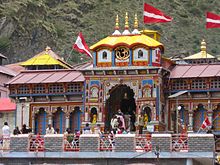| Badrinath Temple | |
|---|---|
 The temple with steps leading to the entrance | |
| Religion | |
| Affiliation | Hinduism |
| District | Chamoli district |
| Deity | Badrinath (Vishnu) and Badridevi (Lakshmi) |
| Governing body | Shri Badarinath Kedarnath Temple Committee |
| Location | |
| Location | Badrinath |
| State | Uttarakhand |
| Country | |
| Geographic coordinates | 30°44′41″N 79°29′28″E / 30.744695°N 79.491175°E |
| Elevation | 3,100 m (10,171 ft) |
| Website | |
| badrinath-kedarnath | |
| Part of a series on |
| Vaishnavism |
|---|
 |
Badarinath or Badarinarayana Temple is a Hindu temple dedicated to Vishnu. It is situated in the town of Badrinath in Uttarakhand, India. The temple is also one of the 108 Divya Desams dedicated to Vishnu—holy shrines for Vaishnavas—who is worshipped as Badrinath. It is open for six months every year (between the end of April and the beginning of November), because of extreme weather conditions in the Himalayan region. The temple is located in Garhwal hill tracks in Chamoli district along the banks of Alaknanda River. It is one of the most visited pilgrimage centers of India, having recorded 2.8 million (28 lakh) visits in just 2 months in 2022.[1] It is one of the Char Dham pilgrimage sites.
The image of the presiding deity worshipped in the temple is a 1 ft (0.30 m), the black granite deity of Vishnu in the form of Badrinarayan. The deity is considered by many Hindus to be one of eight svayam vyakta kshetras, or self-manifested deities of Vishnu.[2]
Mata Murti Ka Mela, which commemorates the descent of river Ganges on mother earth, is the most prominent festival celebrated in the Badrinath Temple. Although Badrinath is located in North India, the head priest, or Rawal, is traditionally a Nambudiri chosen from the South Indian state of Kerala. The temple was included in the Uttar Pradesh state government Act No. 30/1948 as Act no. 16,1939, which later came to be known as "Shri Badarinath and Shri Kedarnath Mandir Act". The committee nominated by the state government administers both the temples and has seventeen members on its board.

The temple is mentioned in ancient religious texts like Vishnu Purana and Skanda Purana. It is glorified in the Naalayira Divya Prabandham, an early medieval Tamil canon of the Alvar saints from the 6th–9th centuries CE.
- ^ "Uttarakhand: 28 lakh pilgrims visit Char Dham in 60 days, choppers flying like auto-rickshaws, experts warn of consequences". The Times of India. 10 August 2022. Retrieved 12 August 2022.
- ^ Sen Gupta 2002, p. 32
